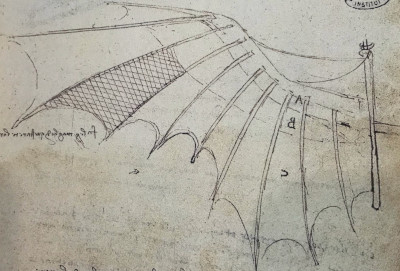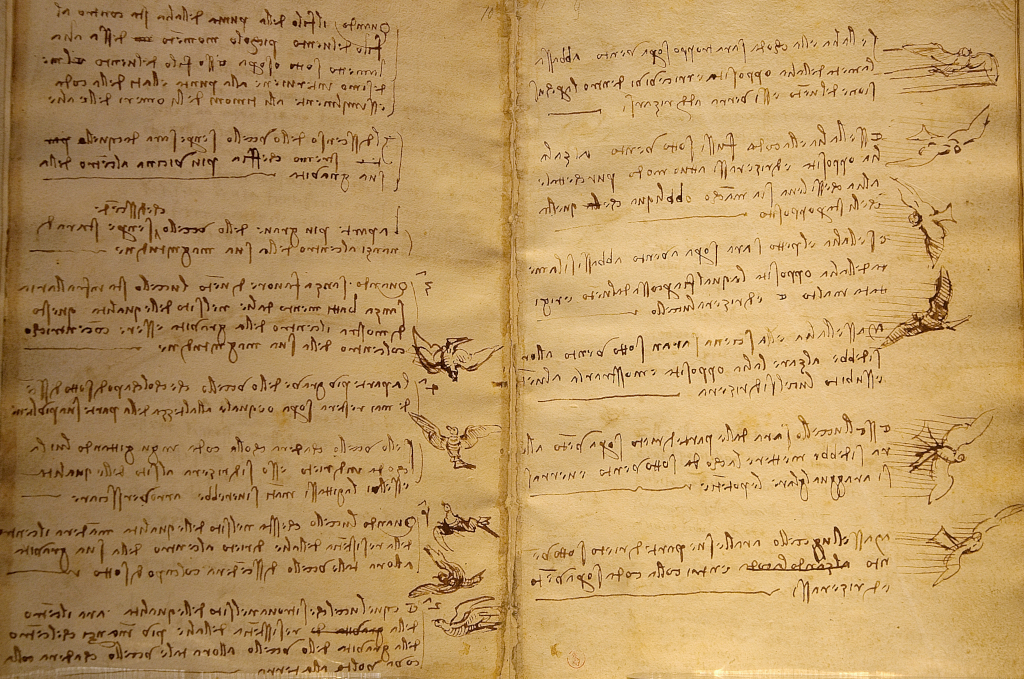Leonardo da Vinci went to extraordinary lengths in order to design a flying machine, and combined his knowledge of nature and engineering to come up with a variety of ideas.
The Renaissance Man may have been, ultimately, unsuccessful in delivering a working prototype of his flying machine, but he did make a number of significant advancements which aided science and engineering in later centuries. Here we examine that creative path that he went on, and some of the early airplane designs that he came up with.
Leonardo would experiment with different positions for the pilot, even creating a floating ship fairly on in his research. Eventually he would focus more on the traditional flying machine formats, with flapping wings and a much closer remsemblance towards the anatomy and actions of a bird.3
The engineer attempted to re-create the flapping wing method for humans, but immediately realised a number of issues in generating enough power to keep a human in flight (Ornithopter). He contemplated that gliding would be far easier to achieve, producing ideas which are similar to modern day one-man gliders.3
"...Study the anatomy of the wings of a bird... Do the same for man to show the possibility that man could sustain himself in the air by the flapping of wings..."
Leonardo da Vinci, within his study notes, as documented in Leonardo da Vinci by Walter Isaacson
For many centuries Leonardo da Vinci was only remembered as a painter, with most Europeans aware of classic works such as Mona Lisa, The Last Supper and Ginevra de' Benci. However, more recently, his notes and engineering designs have been studied in greater detail, and experts have analysed his work in all of the different disciplines in which he worked.
His innovations within the world of engineering, science and mathematics are now well documented, and a much more rounded view of his achievements has finally been established. Da Vinci's sketches and research into flying machines, and early airplane prototypes, have risen in popularity. Some have even gone as far as to build prototypes in order to test some of his designs out.
Whilst we focus on winged designs resembling early plane designs within this article, Leonardo would continue his curiosity into other related projects, such as parachutes, helicopters and also land-based vehicles. Those who have examined Leonardo's designs for flying machines have generally concluded that his scientific research and experiments were based on sound logic, but he could never overcome the issues around man being able to generate enough power to carry its weight in mid-air.
The artist's study of birds would inspire much of this work. He was essentially attempting to replicate their attributes and abilities using man-made designs. The challenge would ultimately prove too much for Leonardo to solve, but eventually humanity would complete these tasks, giving us today's airplanes, helicopters, gliders and so much more.
Within this article we take a thorough look into the different flying machine designs produced by Leonardo, as well as the findings that he made. We consider the influence and significance of his contributions to this field of innovation, and also his wider impact on the evolution of science as well. There is also some consideration of how his engineering inventions sat alongside his work in other disciplines in this varied career.
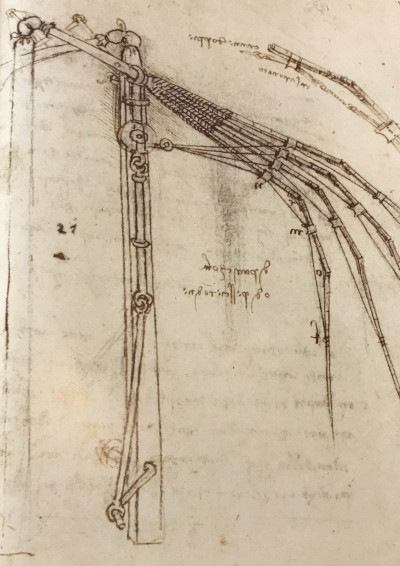
Flying Machine in Action, 1486-1490
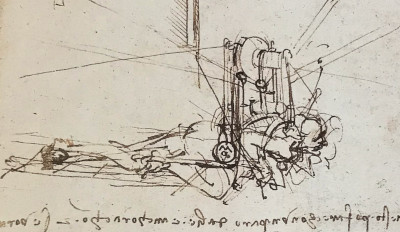
Studies of a Flying Machine with a Hand and Foot-Powered Mechanism 1487-1490
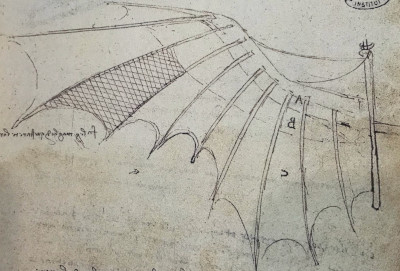
Studies of Wing Articulation 1487-1490
Table of Contents
- Leonardo's Inspiration and Dream of Flying
- Leonardo's Studies on Bird Flight
- Questions Regarding Da Vinci's Flying Machines
- Da Vinci's Findings
- Legacy
- References
Leonardo's Inspiration and Dream of Flying
Leonardo had always been interested in the natural world, and would observe it in order to understand how it worked. He would sketch the human and animal anatomy endlessly, delving into the details of how each action was produced. This resulted in an impressive handling of muscle and bone structure within his paintings and drawings.
We would see within Vitruvian Man at how the artist saw the complexity of the human world, and the way in which everything is interlinked, was similar to the wider world. He believed that in understanding the various elements of anatomy, that perhaps he could start to understand the world in which we live, with much still to be discovered at that point in European history.
Theatre Production
The artist worked on several theatrical productions in his early years, under the guidance of his master, Andrea del Verrocchio. The various techniques used to create the illusion of flying human figures amused and inspired the young artist. He would see both birds and people lifted into the air, delighting the crowd - Da Vinci immediately wondered to himself, could this be done in real life? He would later set about trying to achieve this.2
Leonardo's early interest in bird flight was, therefore, not actually about replicating this in humans, but about creating exciting theatrical productions, akin to a magician seemingly making the impossible happen before the audience's eyes. In order to make these innovations look real, Leonardo spent time in the 1480s researching various flying creatures, to understand how they achieved this feat.
The artist would then make use of existing theatrical methods to bring these designs to life, using a series of basic engineering techniques, such as gears and pulleys, operated by workers out of sight. He may have had no intention of moving towards human flight at this stage, and only considered how to deliver believable experiences for Florence theatre-goers.
Leonardo's Studies on Bird Flight
Leonardo has always been highly regarded for his skills of observation, which laid the foundations to his success in a wide variety of disciplines. He studied birds in detail, and reached the point at which he could differentiate between various species of bird, and understand how their flight techniques varied. Eventually, he decided to bring together all of his findings into a publication which became known as his Codex on the Flight of Birds.
Codex on the Flight of Birds
This bright man could not simply use the flight of birds as his starting point, for he would have to go further back and deeper into the workings of the world. He tried to understand how any creature could remain in the air, and what part the natural wind would play within that. He had already observed the impact of wind on water in a series of study drawings, and started to connect flight to this topic.
He would eventually develop an early understanding of gravity and air pressure, which helped him to understand how a bird could generate enough strength to remain mid-air, despite its relative weight. His findings would be taken on and developed in later years by major scientists who had additional knowledge and time necessary to formulate accepted laws of physics.2
Leonardo would also observe that the impact of gravity or air would alter, depending on the speed of an object and from that point onwards he better understood the natural design of birds' wings, and the importance of air flow and glide. It is this knowledge which later led to the Leonardo glider, which appeared after he had concluded that keeping a human in mid-air purely from flapping wings could not be achieved at that stage.
Questions Regarding Da Vinci's Flying Machines
- Did Leonardo da Vinci's Flying Machine work?
- When was the Flying Machine invented by Leonardo?
- What machines did Leonardo da Vinci fly?
- Why did da Vinci design flying machines?
- Did da Vinci test his flying machines?
- What types of Flying Machines did Da Vinci invent?
Did Leonardo da Vinci's Flying Machine work?
Da Vinci's flying machines were never tested by the Renaissance Man himself, but modern engineers would be able to make them work using modern materials and some small adjustments to his original work. The fundamental ideas often proved workable, and with more time Leonardo may well have been able to produce workable prototypes.
There remains a legend of how an apprentice broke his leg whilst trying out one of Leonardo's flying machines, but most academics believe this story to be entirely fictitious as there are no accounts of it within his notes, nor any other supporting evidence.
When was the Flying Machine invented by Leonardo?
What machines did Leonardo da Vinci fly?
None of Leonardo's flying machine designs would not make it beyond the planning stage. If the Renaissance Man had attempted to fly any of his designs, he likely would have failed to take off at all, or worse still, caused himself significant injury.
However, modern scientific knowledge and light-weight materials allowed engineers to create working prototypes from his original machine designs in the 20th century which demonstrated the sound scientific discoveries made by Leonardo within the Renaissance era.
Why did da Vinci design flying machines?
Leonardo was obsessed with nature, but also determined to understand its intricacies. He believed that the inner workings of every creature symbolised the wider world. He would stand and watch birds in flight from the hills of Fiesole, on the outskirts of Florence. He eventually would desire to experience the same, and set about producing flying machines for humans to use.
The artist also worked on theatre designs early on in his career and would construct mechanical creatures that could be used on stage to mimic the same behaviour of birds and animals. He believed his early designs were too primitive and he wanted to go beyond just creating the illusion of flight, for theatre go-ers.
The artist was also observing the principles of physics, such as gravity and mass, and in designing flying machines he could attempt to evolve these primitive theories through experimentation. Ultimately it would be left to others to expand on his findings, to produce the workable machines of today.
Did da Vinci test his flying machines?
There is a common tale of how Leonardo da Vinci tested one of his flying machine designs in Fiesole, Tuscany. He persuaded an apprentice to man the machine, and a later accident caused the young man to break his leg.
No real evidence exists to support this story, and most experts on Da Vinci's life have rejected it as mere legend, and highly unlikely to have actually occurred. Crucially, thousands of pages of notes written by Da Vinci have been studied in detail, and there is no mention of this test, whatsoever.
What types of Flying Machines did Da Vinci invent?
Da Vinci's Findings
After many attempts at re-creating the actions of a flapping bird, but with enough power to keep a human in flight, Leonardo eventually realised that this was not possible. He simply could not find a way to generate enough power to cover the weight of a human, and so sought new ways of achieving much the same result. This pushed him towards gliders instead, as he realised that far less power was needed when fixed wings could keep a moving objects off the ground.
Legacy
Leonardo was remembered only as a painter for several centuries, but eventually his achievements in other disciplines would be recognised and documented. By the 20th century it would become fashionable to create genuine prototype models based on some of his early designs, with the more authentic projects only making use of the materials and scientific knowledge that existed at the time.
The general concensus around Leonardo's flying machine designs is that some tweaks would certainly have been required in order to make them work effectively, but that the inventor did contribute a lot to modern science, through the discoveries that he made.
It took time for other specialists to evolve his theories, and in combination with modern, lighter resources, he was close to producing workable ideas. Even the briefest of surveys of his drawings will uncover clear similarities between his ideas and later machines which have evolved over the past few centuries, and this cannot be entirely a coincidence.
References
- Leonardo. The Complete Paintings and Drawings, Frank Zöllner & Johannes Nathan, Taschen
- Leonardo da Vinci, Walter Isaacson
- The Science of Leonardo, Fritjof Capra



